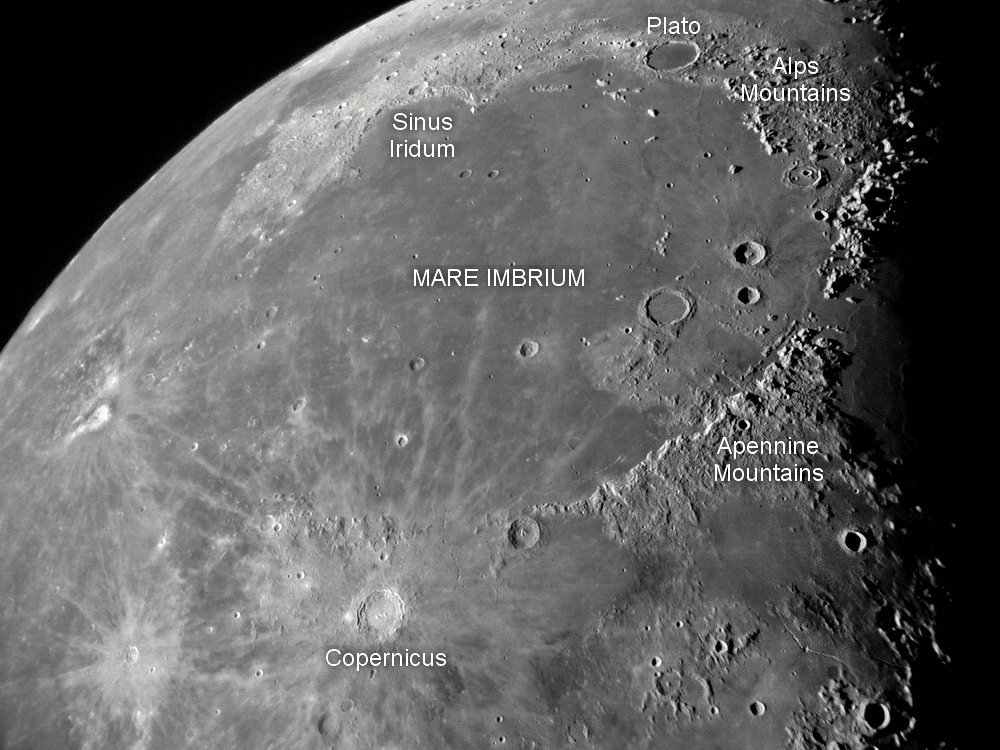
In ancient times Hellenistic Greeks travelled many, many months to visit the Seven Wonders of the World, which included such magnificent sights as the Pyramids of Egypt and the Hanging Gardens of Babylon. I’ve often wondered what lunar destinations would top a future visitor’s list of must-see attractions. But until we can travel there in person, we’ll have to make do with touring the lunar surface with our telescopes.
Here is my selection of Seven Wonders of the Lunar World, chosen with an eye toward sights that are diverse, visually compelling, and geologically interesting.
1. The Secondary Craters of Copernicus
Sporting a prominent ray system, central mountain-peak complex, and ruggedly terraced walls, Copernicus is a awesome sight. But a little-noted feature that makes it a stand-out is its swarm of associated secondary craters. These pits are the product of chunks of debris kicked up by the initial, powerful impact that created Copernicus. Check out the distinctive chain of secondaries scattered east and northeast of the main crater (keeping in mind that lunar east and west are opposite sky directions). These craterlets are only a few kilometres across, and if you look carefully, you’ll see that most are elongated and many merge with their neighbours.
2. Flat-floored Plato
When the Moon’s phase reaches waxing gibbous, the eye is inevitably drawn to the arching span of the Lunar Alps, punctured by the dark grey oval of Plato. The interior of this 109-kilometre-diameter crater seems improbably smooth. Unlike Copernicus to the south, Plato lacks the usual central mountain peak and rubble-strewn floor typical of craters this size. The difference is that Plato was filled halfway to the rim with lava that seeped up through cracks in its floor and formed a mini-sea of frozen basalt. For a real challenge, try to spot some of the tiny craters dotting Plato’s placid smoothness. You’ll need moderately high magnification in your telescope and steady seeing conditions to pull off this sighting.

3. Magnificent Mare Imbrium
The largest feature on the Earth-facing side of the Moon is the 1,200-kilometre-wide Imbrium impact basin. Its northern and eastern rims are defined by the lunar Alps and much of the southern arc is delineated by the Carpathian and Apennine mountains — all features worthy of prolonged telescopic investigation. Imbrium’s most conspicuous aspect though is the huge mare that fills the impact cavity. Known as Mare Imbrium, this feature didn’t form immediately after the Imbrium impact, or even all at once. Indeed, you can see the differences in tone and texture in the mare that hint at individual episodes of lava flooding.
4. Mysterious Messier and Messier A
Craters come in many sizes but generally have one thing in common: they’re round. However, not all craters fit this mould. Deep in the heart of Mare Fecunditatis you’ll find the oddball pair of Messier and Messier A — two distorted, small craters produced by a single impactor. Both craters are elongated, and Messier A (the westernmost of the two) sports a pair of antenna-like rays. Their weirdness is the result of the peculiar way they formed. A chunk of debris struck the lunar surface at a very shallow angle (creating Messier), ricocheted, then blasted out Messier A and its strange rays.
5. The Bay of Rainbows
One of the most arresting sights along the terminator of a 9- or 10-day-old gibbous Moon is the golden handle of Sinus Iridum arcing into the darkness of the lunar night. Also known as the Bay of Rainbows, the scene is as striking as the fanciful name would suggest. However, rather than a bay, Sinus Iridum is really a partially submerged, 260-kilometre-wide crater. It looks like a bay because its entire southern rim is missing. What happened to it? The likeliest explanation is that the crater formed on the gently sloping banks of the Imbrium Basin. When the basin filled with lavas, Sinus Iridum lost its low, southern rim.
6. The Marius Hills
Honest-to-goodness lunar volcanoes are rare. But one place where you can see a whole bunch of lunar volcanoes is along a swath of Oceanus Procellarum, west of the crater Marius. There you’ll find dozens of lumpy little volcanoes, looking like a rash on the otherwise smooth mare. In all, there are some 300 such domes, each 3 to 10 kilometres diameter, and a few hundred meters high. While no single volcano in this group is especially remarkable, their sheer number makes the region a fascinating place to visit with your telescope.
7. Tycho the Titan
When the Moon is full, most attention-grabbing crater on the lunar surface is Tycho. Even binoculars show its magnificent set of rays, streaking outward many hundreds of kilometres from the 102-kilometre-wide impact scar. Because crater rays don’t last very long in the harsh environment of the lunar surface, they’re a mark of relative youth. Indeed, Tycho is only about 109 million years old — not exactly young by human standards, but only yesterday in the geologic scheme of things. When the Moon is near full, you can also see that Tycho is delineated by a dark halo of glassy impact melt — one of the few craters to sport such a feature. Tycho is also worth a look when the terminator is nearby. Pump up the power and admire its central-mountain peaks and terraced crater walls — all hallmarks of a large, complex crater.







